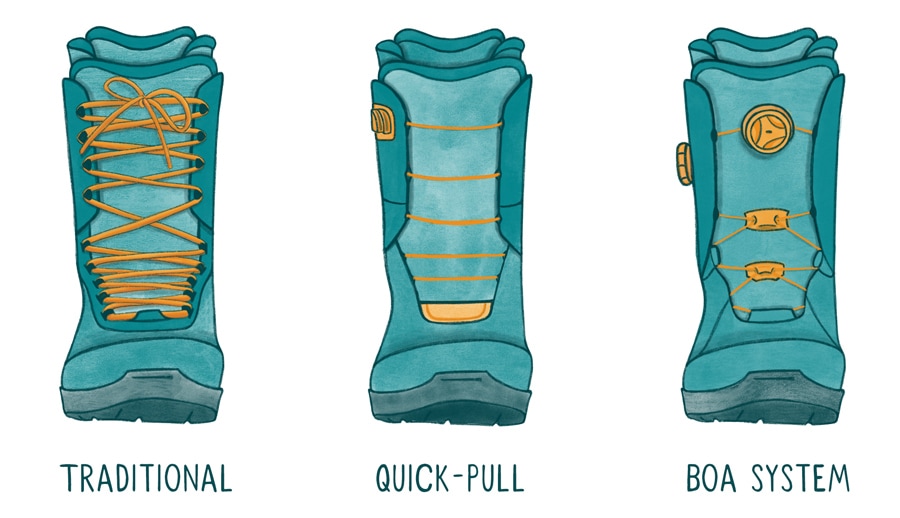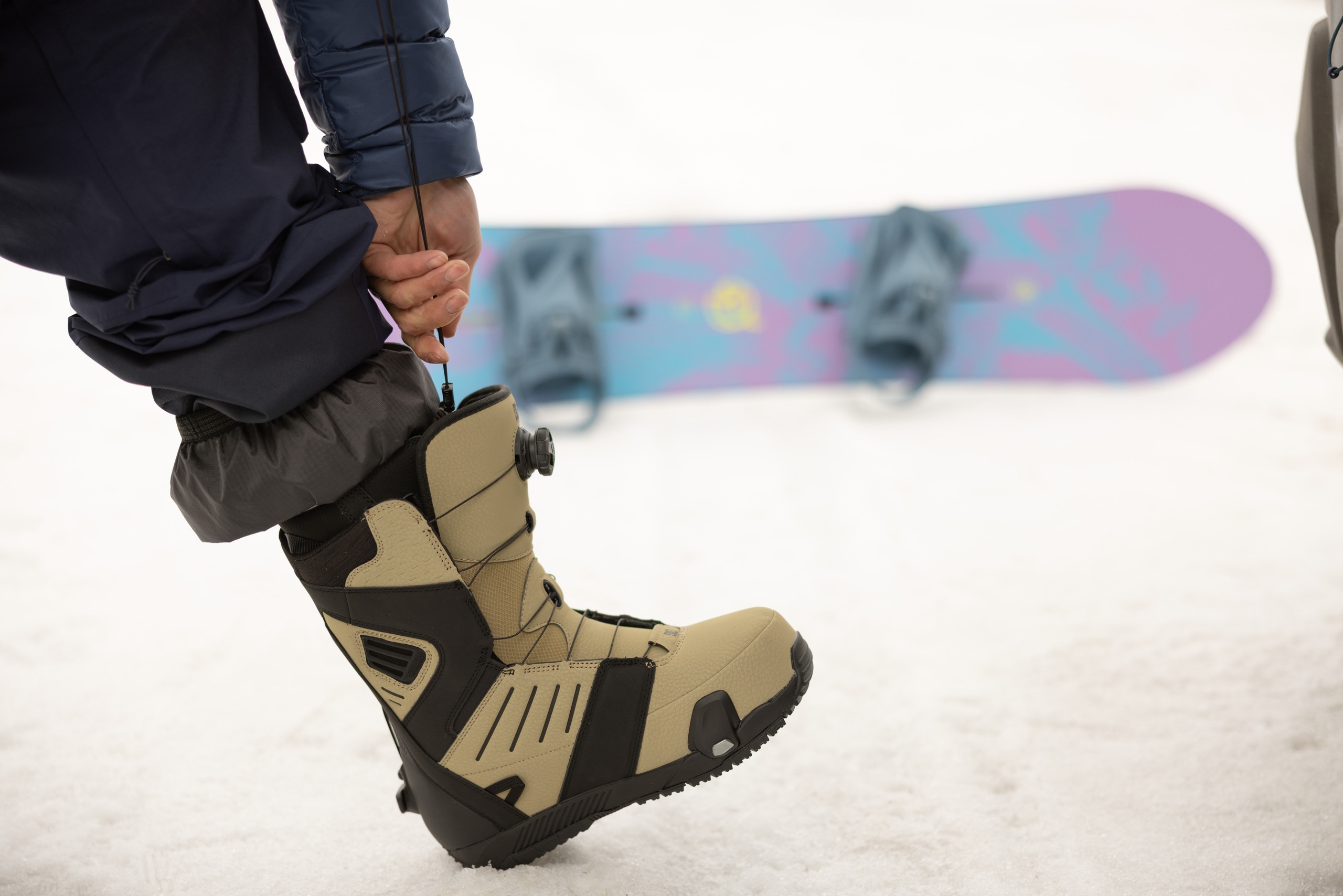Snowboard boots are arguably the most important of your setup. Having a well-fitting pair of boots is key to a great day of riding. Boots, more than a board, are where to splurge a little if you can afford to do so to ensure you get the right fit.
The snowboard boots you select should be well matched to your usual riding style and the snow conditions you most frequently encounter.
This article will cover:
- Snowboard riding style and boot flex
- Snowboard boot lacing systems
- Finding the right fit
- Snowboard boot liners
Snowboard Riding Style and Boot Flex
Your goal: Find boots designed to perform where and how you usually ride.
Snowboard boots are typically categorized as soft, medium or stiff. Boot flex is often a personal preference, but flex does align roughly with the type of snowboarding you do.
Boot Flex
Flex Type | Benefits | Ideal For |
|---|---|---|
Comfortable, resilient materials; easy on feet for long days | Beginners, recreational riders, park/freestyle riding | |
Balances mobility and support; all-mountain performance and comfort | All-mountain riders | |
Maximum support for edge power and control at high speeds | Advanced riders, freeride, high-speed carving |
Finding snowboard boots with a flex that matches your riding style can make a big difference.
- Soft flex: Soft-flexing snowboard boots have comfortable, resilient materials that are easy on your feet for long days on the mountain.
- Medium flex: These boots provide a balance of mobility and support for all-mountain performance and comfort.
- Stiff flex: Stiff-flexing boots have maximum support for edge power and control at high speeds and in tough conditions.
You can find a boot's flex rating in product specs on REI.com. But keep in mind that boot flex may vary between brands. A "soft" flex boot from one brand may feel stiffer than one from another brand. If possible, visit an REI store to try out boots in person to get a feel for what suits you.
Riding Style
What's your riding style? All-mountain? Freeride? Freestyle? An all-mountain or freeride boarder with a taste for speed, for example, will likely want more responsive boots, which tend to be stiffer models. Park riders and recreational snowboarders generally prefer something softer and easier to maneuver. Consider also your personal preferences on comfort and fit.
Here are general flex recommendations to get you started:
Snowboard Riding Style | Terrain | Snowboard Boot Flex |
|---|---|---|
All-Mountain | Groomers, untracked powder, some park | Soft to medium boots for most riders; stiffer boots for fast riding, racers |
Freeride | Off-piste (untracked backcountry), some groomed runs | Stiffer boots for edge power and control at high speeds |
Freestyle | Park terrain (half-pipe, rails, jumps, tricks) | Softer, more flexible boots for quick responses and maneuverability |
What category of rider are you? Here's how each is defined.
- All-mountain: Refers to any terrain suited to a snowboard—groomers, untracked powder and even some park-and-pipe. The majority of riders are all-mountain riders, and the majority of all-mountain riders will gravitate toward more flexible boots. Softer boots are ideal for beginners. For fast riding, however, choose stiffer boots. Backcountry splitboarding usually falls into this category.
- Freeride: Encompasses off-piste (untracked backcountry) terrain and some groomed runs, but not terrain parks. Freeride is sometimes also referred to as "big mountain" riding. Freeriders place a premium on speed and precision, so stiffer boots are preferred. This rigidity helps generate edge power for scribing lines across icy (firm) snow.
- Freestyle: Fun-focused terrain (half-pipe, rails, jumps, spins, jibbing and tricks). Maneuverability, feel and quick responses are vital to the park experience, so softer, more flexible boots are the usual choice.
Within the above categories, you'll find styles specific to women and kids. What makes these styles distinct?
Snowboard Boot Lacing Systems

Snowboard boot lacing is important. Boots should be laced tightly yet feel comfortable and be free of blister-causing pressure points. Ankles and heels ought to remain securely in place, with minimal heel-lift—no foot shimmying at all (front to back, side to side), if possible.
Most snowboard boots offer one of three lacing systems—traditional, quick-pull or Boa. Some boots feature a hybrid design that blends 2 of these systems. Each system is fast, handy and secure, and no single system decisively outperforms the others. The system you choose is mostly a matter of personal preference and budget.
Traditional Laces
These are tried-and-true and, for the most part, foolproof. On some boots it's possible to replace stock laces with specialty or designer laces.
Pros:
- Tightness of the fit can be customized by hand.
- Inexpensive.
- Replacement laces are easy to locate.
Cons:
- Difficult to tie while wearing gloves or when bare hands are cold.
- Vulnerable to unintended loosening.
Quick-pull Laces
This single-pull, corset-like lacing system is fast and accommodates zonal tightening. That means you can fine-tune the tightness of forefoot lacing independently from the ankle and lower leg.
Pros:
- Fast and convenient.
- Can be tightened while wearing gloves.
- Lace-pulls usually tuck away neatly.
- Several systems offer independent high-low (ankle-foot) laces for a customizable fit.
Cons:
- May initially appear complex.
- A few riders find they cannot exert enough pull to tighten laces as snugly as they would like.
- Points (usually eyelets) where laces attach to boots can sometimes create pressure points.
- Somewhat vulnerable to unintended loosening.
- If lace wears out or breaks, it could prematurely end a day of riding.
Boa System
The Boa system consists of small-diameter cables (usually small strands of stainless steel) attached to one or two knurled wheels or dials that adjust the snugness of the fit. If two dials are used, one is on the top of the boot tongue and another is near the ankle. Boa permits a very precise fit around the foot and lower leg.
Pros:
- Fast, easy and convenient.
- Usually requires just one hand.
- Simple to modify during a pause in activity.
- Can be adjusted while wearing gloves.
- Offers a precise, fine-tuned fit.
- Excels at shedding grit and slop.
Cons:
- One-dial system applies uniform snugness throughout foot, so upper and lower foot regions cannot be independently customized.
- Points where strands attach to boots can sometimes create pressure points.
- If a strand breaks, it could prematurely end a day of riding.
- Adds to boots' overall cost.
Finding the Right Fit
A good fit starts with purchasing the right size boot.
Snowboard boots typically use standard U.S. sizing. Sizes are not always uniform by brand or even from one model to another. A size 9 in one brand might not feel the same in another. If possible, shop for boots later in the day, since feet naturally swell to a larger size during afternoon and evening hours. In this short video we show you how to try on snowboard boots:
Video: How to Size Snowboard Boots
How Boots Should Fit
Boots should fit snugly but not so tight that your feet feel cramped. Over time, liners soften up a bit and gain a touch of what is known as "volume" inside the boot.
Don't be tempted to buy a boot that feels loose or sloppy out of the box. It's OK for toes to just barely graze the boot's toecap.
Ensure that the fit in the rear of the boot is snug. This is where your bones lever the board onto its edge. Heel-lift is the enemy of performance-minded snowboarders; when you lean forward you want your board, not your heels, to rise.
Women's: These styles are customized to address women's specific anatomical needs, such as narrow heels. The majority of women's choices fall on the soft-to-medium end of the spectrum.
Kids': Some kids' boots offer footbeds with peel-away layers to accommodate growing feet. Avoid getting dramatically oversized boots hoping that your young boarder will grow into them. Equip a child with boots sized correctly for the season ahead.
Snowboard Boot Liners
"Liner" refers to the entire inner boot of a snowboard boot. Liners are commonly made from ethylene vinyl acetate (EVA), which is a lightweight, moldable polymer that most people associate with foam rubber. As it does in running shoes, EVA provides cushioning, stability and insulation for a snowboarder's feet.
Some boots have removable liners that can be removed from a boot when you're done riding. This allows them to air out and dry faster than nonremovable liners.
Liners fall into three basic categories:
- Non-moldable (stock): Less pliable than other options, stock liners provide generic padding and stability for your feet. Over time the sustained pressure of your body weight will likely cause the liner's forefoot section to conform to that section of your foot's shape.
- Thermoformable foam liners use your foot's heat to achieve a custom fit. They break in after a day or so of snowboarding.
- Custom moldable liners use an artificial heat source to achieve a custom fit. Though best done at REI or other ski shops with boot-fitting expertise, it is possible to do at home.
Snowboard Socks
If shopping for boots in a store, wear synthetic or merino wool snowboard socks during the try-on phase. These thin, smooth-faced socks allow moisture to pass through easily while producing less friction and fewer hot spots. Bundling your feet under multiple layers of bulky socks is a recipe for a sloppy stance.
